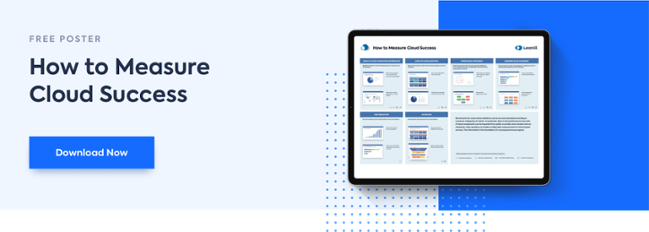
Discussions about the cloud tend to polarize. Some only see the risks to security and privacy, while some suppliers, on the other hand, sell the cloud as a cure-all for all IT issues. It is time to take an objective look at the pros and cons and how Enterprise Architecture (EA) can help you succeed in the age of the cloud.
Even traditional companies, wary of the public and hybrid cloud for years, are slowly becoming more trusting. They increasingly value the advantages of the cloud operational model, which offers fast and flexible access to high-performance infrastructures and applications. It's now less a question of if cloud services should be used, but instead how and which. In addition to the market leader AWS, competitors like Microsoft with Azure, Google (Compute and App Engine), IBM (Softlayer and Bluemix) are now offering serious alternatives for public clouds.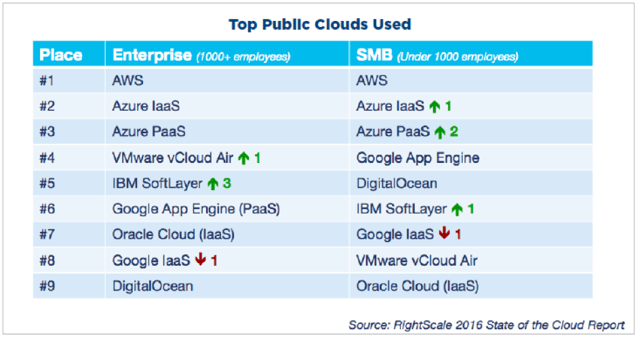
Compared to established companies, young startups have the advantage that they can build their cloud landscape in open fields. Large traditional companies, however, face the challenge that they must formulate a cloud strategy for business-critical applications developed over many years or even decades. Enterprise Architecture can aid in developing the right strategy for deciding which applications should be migrated to the cloud and also in carrying out the migration. EA does not only have an overview of the company's technologies but also of the business drivers, skills, processes, and data requirements.
The future is cloudy
Even if some companies decided against the cloud a while ago, they now often rely on cloud-based services, which are sometimes brought in through the back door. Even organizations that are officially against the cloud can hardly avoid them, even if the use of cloud services sometimes takes place outside of official policy. Gartner analysts even believe that by 2020 a "no-cloud" policy will be just as rare as a "no-internet" policy is today. Instead, they predict that the hybrid cloud (a mixture of internal and external cloud services) will be the most used solution. According to a survey by RightScale, this solution is already preferred by most companies.
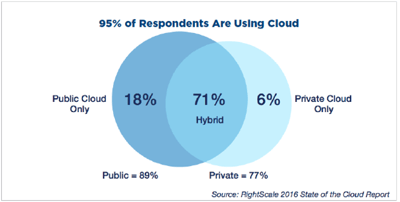 This trend is supported by the fact that software is now frequently published first as a cloud version and that in the future often a cloud-only version will be available. More and more innovation will take place only in the cloud, and, accordingly, only organizations who are open to the cloud will benefit.
This trend is supported by the fact that software is now frequently published first as a cloud version and that in the future often a cloud-only version will be available. More and more innovation will take place only in the cloud, and, accordingly, only organizations who are open to the cloud will benefit.
The path to the cloud
Companies have a lot to consider when developing their cloud strategy:
- How much complexity can they and do they want to accept? Web applications can be a collection of changing parts. For example, a single web application can include 60 interdependent apps, all of which must function so that it runs smoothly.
- Can their development and deployment processes support cloud scenarios?
- Are their suppliers willing to support their cloud strategy? What happens if their cloud provider declares insolvency or decides to stop offering the cloud?
- Are you ready for the costs? If you migrate the wrong applications to the cloud, this may result in higher operating costs. Your reputation could suffer if publicly available applications fail.
The use of EA tools is implicitly useful in order to succeed in developing your cloud strategy, as long as it meets the following requirements:
- It must support the necessary flexibility in modeling.
- It must be easy to put objects into your EA inventory and to bring them out again.
- You need cutting-edge, easy-to-use graphic reports.
- Inventory maintenance must be ensured in the long term.
- It must support agile development.
A good EA tool supports you in assessing how ready your application portfolio is for the cloud. To find out if and which applications you can migrate to the cloud, you need to ask yourself a series of questions, including:
- Which applications should you migrate to the cloud?
- Which applications should you not migrate to the cloud—and how do you find this out?
- Which applications are based on no longer supported/obsolete technologies, hardware, or operating systems and need to be rewritten to run in the cloud?
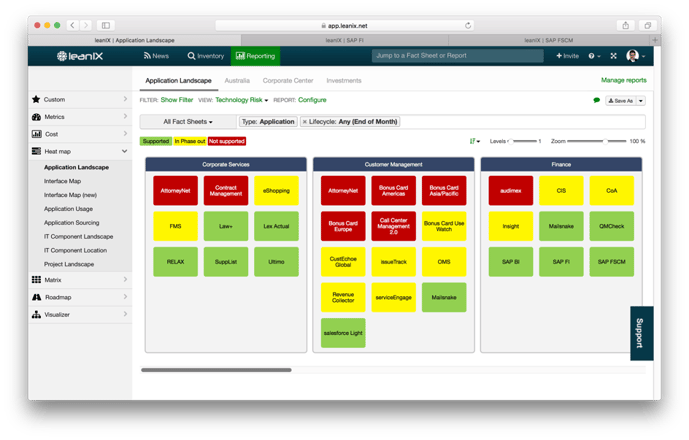
A report that shows which applications are based on obsolete technologies.
- Which applications require simple modifications to run in the cloud?
- What is the schedule for rewriting applications, and which business capabilities are involved?
- Which business capabilities can benefit from new, cloud-native applications?
- What dependencies exist among your applications; what data do they exchange?
- If an application fails, which dependent applications, user groups, and capabilities will be affected?
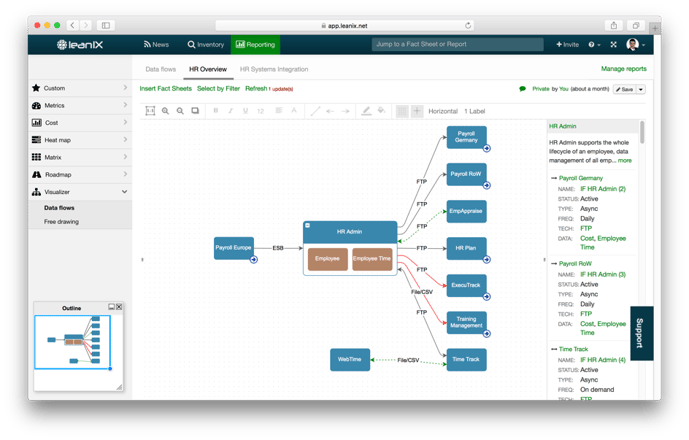
Visualizations of the data streams show dependencies in the application portfolio that need to be taken into account when migrating to the cloud.
In addition to your application portfolio, you need to consider other aspects in developing your cloud strategy. Do you need to adapt your IT processes, for example, and introduce agile methods? Do you have the necessary knowledge within your company to rewrite applications or to develop new, cloud-native applications? It is also particularly important to keep safety in mind. The latest security technologies underlie most modern cloud platforms, which often makes them safer than on-premise data centers.
The path to the cloud is not only a replacement for your traditional infrastructure but will also radically change your processes. Know what you want to achieve and how the cloud will change your company. If you would like to learn more about how LeanIX can support your transition to the cloud, please contact us!
